



.jpg)
Ce belvédère a pour fonction de scène principale lors des événements de grande importance royale comme défilé militaire, cérémonie de lecture des titres de doctorat à haute voix, cérémonie annuelle. C'était sur ce belvédère, la cérémonie d’abdication du dernier empereur du Vietnam au 30 août 1945 a eu lieu.
D’après Kinh Dich-Livre de Physique Universelle, les empereurs doivent orienter toujours vers le sud pour maîtriser l’humanité. Pour cette raison, à partir du règne de Gia Long (1802-1819), pour la construction de la Citadelle de Hué, les architectes avaient conçu tout l’ensemble des palais et bâtiments à la direction Nord Ouest-Sud Est ‘‘Toa can huong ton’’ justement pris sur l’axe Nord-Sud, c’est pourquoi l'empereur Minh Mang a décidé de changé le nom Nam Khuyet Dai (Pavillon vers le Sud) de la porte Centrale de façade de la Cité Impériale par la porte Ngo Mon - Porte du Midi.
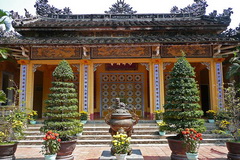
The pagoda includes a main sanctuary with two statues of the Deity Eight Vajra.Dieu De Pagoda was built by King Thieu Tri in 1844 on the platform of 5,000m² in his old residence, where he was born in 1807. It was constructed on a large scale, but was badly damaged during the successive wars....
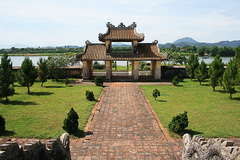
Le temple de la Littérature est un temple confucéen du Viêt Nam, situé sur la rive gauche de la rivière des Parfums à un kilomètre de la pagode de la Dame céleste à l'ouest de la ville de Hué.Sous le règne des...

The tomb of Gia Long is in fact a group of tombs including those of the Emperor's relatives. The whole compound is spread on a joint mountain with 42 small and big mounts, amongst which Dai Thien Tho is the biggest.To visit Gia Long's tomb, tourists can go by boat about 18km along...
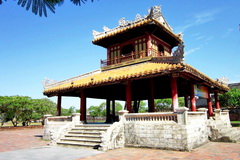
It is a delicate pavilion with a south view. In front of the Pavilion is a large court leading to the Nghinh Luong Pavilion (Pavilion for Fresh Air) on the Perfume River bank.There had once been a tiger - elephant duel on the pavilion grounds in 1829 to entertain Emperor Minh Mang. In his...
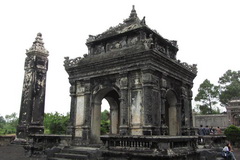
Dong Khanh's Tomb construction lasted through the lives of four Emperors Nguyen (1888-1923). That's why it bears the stamp of two architectural inclinations of two different historical periods. After being crowned, Dong Khanh had a temple built beside his father's tomb named Truy Tu...
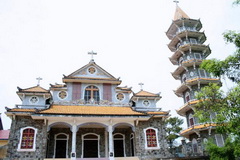
The Hermitage Bien Duc Thien An, usually name Thien Duc Hermitage, has been founded in Summer 1940 by the Bien Duc French hermits with the name of Thien An (Peace from Heaven).The hermitage is formerly managed as an infirmary and a school. To day the hermitage is only a place for religious...
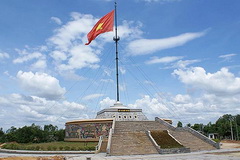
It is commonly known as a flagpole, but viewed from the Imperial City; it is really a huge structure of three flat-top pyramids, one lying on top of another. It was built during Emperor Gia Long's reign, in 1807, and later improved by his son, Emperor Minh Mang.According to the Thuc Luc...
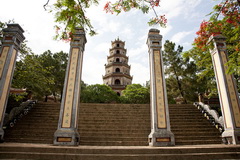
La pagode de la Dame céleste (en vietnamien: Chùa Thiên Mụ) est la pagode la plus haute du Viêt Nam avec les six étages supérieurs de sa tour, dénommée « Source de félicité ». Elle se trouve à Hué sur...
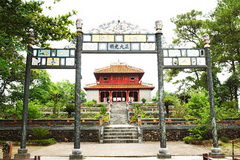
After being on the throne for seven years, Emperor Thieu Tri was sick and died on 4 November 1847 at the age of 41. In his lifetime, the Emperor neither thought of his death nor wanted the people and soldiers to waste so much labour and property for him, so he did not have his tomb built.As soon...
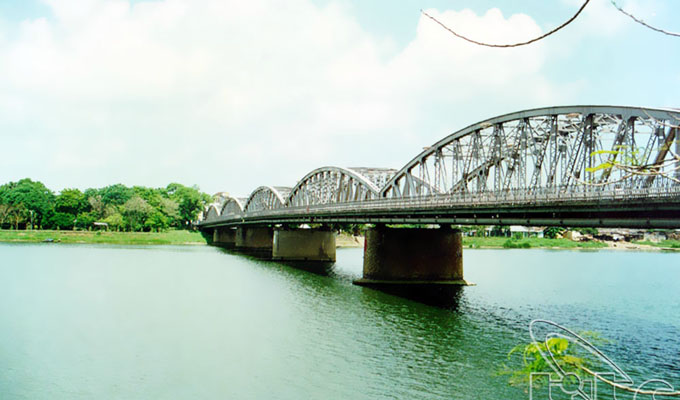
Huê ne serait pas la même sans la rivière Huong ou rivière des Parfums et le mont Ngu Binh, qui confèrent à l’ancienne cité des rois un cadre harmonieux et romantique. Une combinaison d’éléments indissociables que savent...

Soyez le premier à connaître nos offres de voyage exclusives et les nouveaux circuits !.